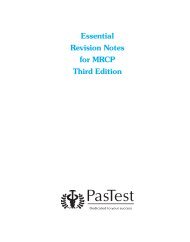SURGICAL FINALS Passing the Clinical - PasTest
SURGICAL FINALS Passing the Clinical - PasTest
SURGICAL FINALS Passing the Clinical - PasTest
- No tags were found...
You also want an ePaper? Increase the reach of your titles
YUMPU automatically turns print PDFs into web optimized ePapers that Google loves.
3The OSCEs andshor t casesObjective structured clinical examination (OSCE) assesses a broad rangeof knowledge and skills in a quantifiable, valid and reliable form. TheOSCE aims to assess your factual recall, your interpretative skills, yourdecision making, your behavioural attitude in professional practice andyour ability to perform particular practical tasks. It ensures that each ofyou is presented with <strong>the</strong> same material and <strong>the</strong>refore provides a uniformevaluation and marking system.The OSCE often includes short cases. These are probably <strong>the</strong> most difficultpart of <strong>the</strong> clinical examination because you will be required to examinea patient under <strong>the</strong> eagle eye of one or two examiners. The examiners willwatch for three things.1. A caring and competent approachYou should always introduce yourself, say what you would like to do andask permission (see page 8). Fully expose <strong>the</strong> part of <strong>the</strong> body that youwish to examine. Remember to compare both sides: if <strong>the</strong> examiner tellsyou to examine one leg, always expose <strong>the</strong> o<strong>the</strong>r leg as well. However,keep <strong>the</strong> patient ‘decent’, eg when exposing <strong>the</strong> legs, cover <strong>the</strong> groin.Before palpation, never forget to ask if <strong>the</strong>re is any tenderness. The patientshould be comfortable at all times. Thank <strong>the</strong> patient and cover him or herup before presenting your findings.2. A good examination techniqueYour examination of <strong>the</strong> short cases should be a smooth, thoroughand slick performance. The only way to achieve this is to practise againand again so that <strong>the</strong> routine becomes second nature. Find a colleagueto work with and examine under observed and, whenever possible,supervised conditions.12
















